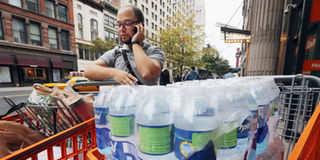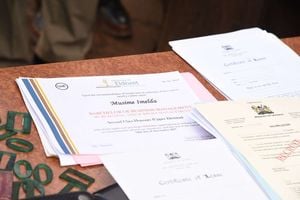New York declares emergency ahead of Sandy

PHOTO | MARIO TAMA Andy Lugo talks on the phone after stocking up on supplies for branches of First Republic Bank in anticipation of disruption from storm elements of Hurricane Sandy on October 26, 2012 in New York City. Some New Yorkers are preparing for possibly devastating effects from the approaching storm.
What you need to know:
- The hurricane, which was headed for a still uncertain landfall on the US East Coast after pounding the Caribbean and the Bahamas, could make a direct hit on New York next week, according to forecasts
- New York Mayor Michael Bloomberg said evacuations of coastal neighbourhoods and a shut-down of commuter trains and buses was possible
- Areas beyond New York City suffered huge power outages and fallen tree damage during Irene and that could happen again, officials warned
NEW YORK
New York's governor declared a state of emergency Friday ahead of the arrival of Hurricane Sandy, while the mayor of New York City said the Big Apple was ready for anything.
"As we prepare for the possibility of Hurricane Sandy hitting New York State, I am activating all levels of state government to prepare for any potential impacts," Governor Andrew Cuomo said.
"We are working with federal and local partners to follow storm developments and organize a coordinated response plan."
The hurricane, which was headed for a still uncertain landfall on the US East Coast after pounding the Caribbean and the Bahamas, could make a direct hit on New York next week, according to forecasts.
By the time Sandy arrives in the crowded New York metro region, it would likely be reduced to a tropical or even regular storm in terms of wind strength, but accompanied by heavy rain starting Monday and into Tuesday, forecasters say.
That could snarl the busy JFK, LaGuardia and Newark airports, cripple mass transit and flood densely populated low-lying areas, as happened when the remnants of Hurricane Irene struck in 2011.
New York Mayor Michael Bloomberg said evacuations of coastal neighbourhoods and a shut-down of commuter trains and buses was possible.
"This is a very dangerous storm. You should pay attention to the various media outlets," Bloomberg told a live news conference. "Sunday, all bets are off but we'll make a bet on Sunday night and tell you what that is."
"We are working on making sure that if we have to evacuate people, we have 65-odd shelters that will be fully stocked," he said.
However, the mayor cautioned against overreacting, given the possibility of the storm weakening, as happened with Irene, or steering past the city.
"At the moment this storm could be a time when we say, 'boy, it's raining,' and nothing more. Let's hope that's the case," he said. "Irene, we thought, would be a disaster for our city and we had virtually no damage."
Areas beyond New York City suffered huge power outages and fallen tree damage during Irene and that could happen again, officials warned.
Cuomo said "although the storm track is still uncertain, Hurricane Sandy has the potential to affect many parts of New York State with a variety of threats including heavy rain, high winds, flooding, tornadoes, coastal surges, and widespread power outages."
"I urge all New Yorkers to closely track the storm's path, using local radio and television or online reports," Cuomo said.
Cuomo and Bloomberg urged residents to stock up on flashlights, food and water, and to have a bag ready with essentials in case of evacuation.
However, nothing will be decided on more extreme measures until more about the system is known, officials said.
The MTA transport network suspends service when winds reach 39 miles an hour (62 kilometres an hour) -- speeds that are forecasted for Monday into Tuesday.




